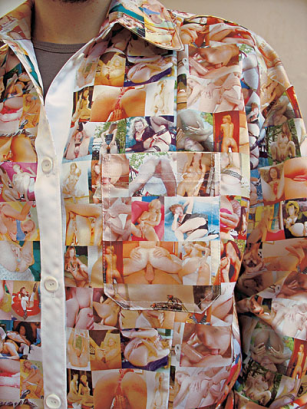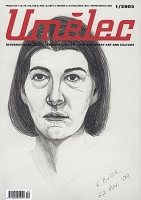| Umělec magazine 2005/1 >> Jiří’s Shirt | List of all editions. | ||||||||||||
|
|||||||||||||
Jiří’s ShirtUmělec magazine 2005/101.01.2005 Lenka Klodová | fashion | en cs |
|||||||||||||
|
Sometimes Jiří Světinský wears a special Shirt. That’s his way of commenting on the problematics of pornography, intimacy, physicality, and issues of ethics and fashion.
Simpler with More Perspective We can identify some apects in common with your work on the Czech scene and people like Jan Stolín. There is a tendency to employ raster, loop, cut and repetition to create an “objective” sample that claims a certain neutrality and indifference towards emotional and ethical values from pornographic and emotionally charged images. Are such images really generally usable? Are they located in any way near anything else from reality? Is it a model for which anything can be used? Or isn’t it possible to separate the emotional content from these depictions? It’s got to be possible to separate the emotional and ethical content from pornography. And it is no wonder, it’s sort of a trick—when someone projects a short loop of a masturbating woman onto a screen, a masturbating machine is thus created that even repeats the short sequence of the mysterious look in her face, we loose our initial shyness and moral inhibitions and are overcome by a feeling of emptiness, of emotional indifference. It is much simpler and perspective to work with the emotional and ethical content that can certainly be found in pornography. You want to uncover pornography, to raise it from people’s darkest regions, to reveal it as the “slime” that it is? I wouldn’t use the word “slime” but it does get my point across. I want people to encounter things that are incompatible in meaning and morality, that disturb and reveal routine mechanisms and thinking patterns. In my experience, such intervention into petrified intimacy is always good. Wouldn’t that be practically even more degrading in the end for the models portrayed? They are trying to excite you, that’s their job. And instead of reacting the way you ought to, one exposes them in a very utilitarian way. Their bared images can show up on your forearm and you mop up a spill on the table of a buffet with it. My dear models can’t be angry with me, I’m doing my job too. And I can imagine their understanding of my efforts. I show how the models are victims of the pornographic industry by splashing their faces on shirts. The More Decent the Behavior, the Stronger the Feeling In the Czech Republic, we tend not to care much about the meaning of the English words on our clothes. But pornogrphic pictures seem to be valued. Ernest Gombrich called them “natural pictures,” understood by everyone (unlike English words) simply because we all have bodies. The shirt is transformed from an article of clothing into a slogan. What does that say about the wearer? What should they convey? Yes, we probably don’t read the words on clothes, but we do count on the popular saying: “Clothes make the man.” If someone meets me and doesn’t know me, and I’m wearing this shirt, they have to somehow put up with it, and that usually requires an immediate response. Although it wouldn’t work much, they’d put me into some box, compartmentalize, and give me some name—lout, womanchaser, playboy or provocateur. They’d have a complex and encourage themself, or they might say, “This man has no taste,” or even, “Wow, that shirt’s cool.” In the worst case: “Well, art...” Anyway, I believe that later people will think it over and they might think about it before falling asleep. And then they won’t be so much in danger, they’d feel relaxed and enjoy a much richer day that had just passed. And who knows, maybe they’d come across something and find in themselves new subjects. Your shirt looks like a vulgar package for an innocent – or at least in the visual sense – innocent body. One would almost beg you to take the shirt off because then there will be less of this nudity and it won’t be so aggressive. Yes, I would say that’s its complementary effect. And the more decent I behave in it, the stronger the feeling of the observers will be. Don’t you, by chance, want your body through that shirt to become attractive and exciting to heterosexual men ? No comment. In your project you found a more female form for attracting attention using striking clothing, unusual accessories and wild fashions. Do you use this tactic in your everyday life as well? Does it work for men? For me it isn’t a way of attracting attention. The shirt might seem extravagant to someone who’s nearsighted and can recognize the naked bodies on it. Otherwise it resembles any colorful Hawaiian shirt. There’s nothing special; it doesn’t attract attention. If I wanted to attract attention, I would have one particular enlarged detail from a pornographic picture printed on my back. That way, I’d be really truly extravagant and very conspicuous, but that would be all, except perhaps for the new nickname I’d get. I prefer to wear gray, a color to blend in with the city. I have the feeling that the city wouldn’t notice me and that would allow me more time to myself. And I like it when women don’t wear make-up, unless it is for an interesting trap. Is it important that you are the one wearing the shirt during the presentation? Can your project be understood as work with your inner feelings? Is it a kind of a self-victimization, exposing oneself to temptation and rumor? No, it’s not important who wears it. But I wouldn’t lend it to anyone without knowing who it was. I think it is very easy to loose the original intention and to become a real lout, provocateur or artist. Yes, there are two experiences, one is for the viewers and one for the exhibiting person. It is a valuable experience which helps to confront my inner feelings with the surrounding world of people. It is alive, and once I am open to it, I can comprehend. Aren’t you bothered that the attention you attract is negative? Is the attention and popularity some kind of sign of evaluation? I don’t like it, I’d rather that people’s reactions be positive. But then I would have peace in my heart and I would loose all motivation and the feeling that I am discovering something. And that’s the same with other people. If I made them happy right away with the shirt, they might soon forget this happiness. It would be just like getting the same present every Christmas, left lying in a box somewhere.
01.01.2005
Recommended articles
|
|||||||||||||








Comments
There are currently no comments.Add new comment